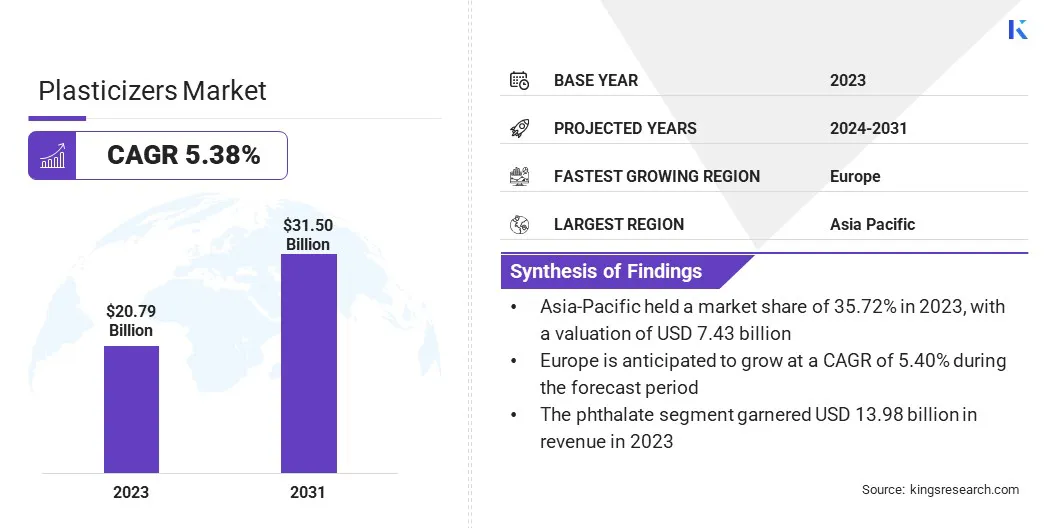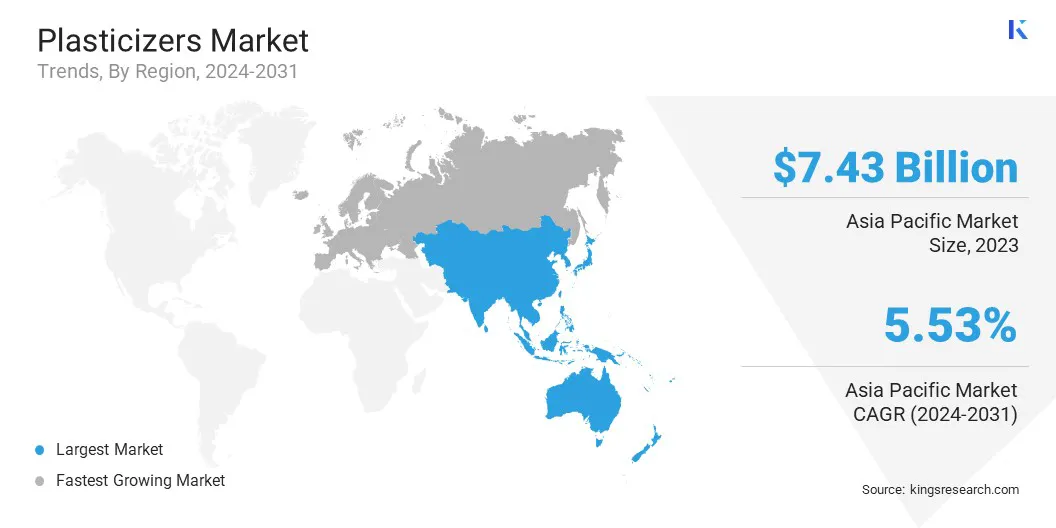Plasticizers market Size
The global Plasticizers market size was valued at USD 20.79 billion in 2023 and is projected to grow from USD 21.83 billion in 2024 to USD 31.50 billion by 2031, exhibiting a CAGR of 5.38% during the forecast period.
The growing demand for plasticizers is driven by their wide range of applications across industries, including construction, automotive, and consumer goods, enhancing flexibility and durability of plastic products.
In the scope of work, the report includes products offered by companies such as BASF, Evonik Industries AG, Eastman Chemical Company, LG Chem, UPC Technology Corporation, DIC CORPORATION, KLJ Group, Exxon Mobil Corporation, Arkema, Bluesail Chemical Group, and others.
The plasticizers market is characterized by a diverse range of products, with applications spanning construction, automotive, healthcare, and consumer goods industries. These additives are widely used to enhance the flexibility, durability, and processability of plastics, particularly polyvinyl chloride (PVC).
With a growing focus on sustainability, the market is shifting toward eco-friendly, bio-based plasticizers. Key players are exploring new product development, responding to regulatory challenges and consumer demands for safer and greener alternatives. The market dynamics is influenced by both technological advancements and the evolving needs of various end-use industries.
- In October 2024, TekniPlex Healthcare introduced bio-based PVC compounds for medical plastics as a sustainable alternative to traditional plasticizers. These bio-based compounds, certified by the ISCC PLUS system, provide similar performance, chemical composition, and regulatory compliance as conventional PVC resins. This innovation aligns with the growing demand for eco-friendly plasticizers in the healthcare industry, promoting sustainability without compromising functionality.
The plasticizers market involves the production and distribution of additives that enhance the flexibility, durability, and workability of plastics, especially polyvinyl chloride (PVC). These additives are widely used in the automotive, construction, healthcare, and packaging applications.
The global market for plasticizers has been segmented by type, application, and geography. Various regulations influence the production and use of plasticizers, focusing on safety and sustainability.
These regulations promote the development of safer, bio-based, and non-phthalate plasticizers, driving innovation and encouraging the adoption of eco-friendly solutions. As a result, the market continues to evolve with a growing emphasis on safer, more sustainable materials.

Analyst’s Review
Plasticizer manufacturers are increasingly focusing on innovation and diversification to stay competitive. Many are investing in the development of bio-based and non-phthalate alternatives to meet regulatory requirements and evolving consumer demand for safer, more sustainable products.
Additionally, companies are optimizing their production processes to improve efficiency and reduce their environmental impact. Strategic partnerships, mergers, and acquisitions are also being used to expand market presence and capabilities, enabling manufacturers to tap into new markets and enhance their product portfolios.
- In December 2023, South Korea's Aekyung Chemical acquired a 50% stake in VPCHEM, a subsidiary of LG Chem based in Vietnam, which specializes in the production and sale of plasticizers. This marked a strategic move to strengthen the former's position in the plasticizers market.
Plasticizers Market Growth Factors
The demand for plasticizers is growing, particularly in food packaging applications. Plasticizers are used to make packaging materials more flexible and durable while ensuring they meet stringent food safety standards, which enables better product protection.
When added to polyvinyl chloride (PVC), plasticizers improve the material’s flexibility, making it suitable for a wide range of industries such as automotive, construction, healthcare, and electrical. This versatility helps manufacturers create materials that are both functional and compliant with industry standards.
However, the use of certain plasticizers, such as phthalates, has raised concerns regarding risks to human health and the environment. These substances have been linked to endocrine disruption and environmental pollution, prompting stricter regulations and growing consumer demand for safer alternatives.
Therefore, manufacturers are shifting toward more sustainable solutions, such as bio-based and non-phthalate plasticizers, which are less toxic and offer improved environmental profiles.
These innovations, backed by research and regulatory support, aim to meet safety standards while reducing the ecological impact of plastic products, helping the industry move toward more sustainable practices.
- Manufacturers are transitioning to more sustainable plasticizers, such as Cargill’s Biovero and Vikoflex. These bio-based, non-phthalate alternatives offer enhanced flexibility, high efficiency, and performance benefits while meeting stringent industry regulations. Biovero plasticizers are derived from renewable resources, providing sustainability and cost savings, while Vikoflex offers customized characteristics, increasing heat and light stability. Both solutions are designed to improve environmental profiles and reduce the harmful impact of traditional plasticizers.
Plasticizers Market Trends
The growing concern over the environmental and health impact of traditional plasticizers has driven the shift toward bio-based alternatives. Bio-based plasticizers, derived from renewable resources, offer safer and more sustainable options, aligning with global trends toward eco-friendly products.
These alternatives not only reduce environmental harm but also support sustainable manufacturing practices. As regulatory pressure increases and consumer demand for green products rises, bio-based plasticizers are expected to see wider adoption, supporting the transition to more responsible and environmentally conscious production methods across industries.
Technological advancements in the plasticizer industry are improving the efficiency and cost-effectiveness of plasticizers. Innovations focus on enhancing performance, stability, and environmental impact of plasticizers, particularly in non-phthalate alternatives.
By refining manufacturing processes and developing new chemical formulations, these advancements make sustainable plasticizers more competitive with traditional options. This progress is driving the adoption of safer, environmentally friendly plasticizers in various industries.
As technology continues to evolve, the shift toward more sustainable and responsible plasticizers is expected to accelerate, meeting both regulatory standards and consumer demand for greener products.
- In July 2024, Eastman Renew plasticizers, made with certified recycled content from Eastman's molecular recycling technology, offer a sustainable alternative without compromising performance. Approved for food contact, these products contain at least 20% recycled content and support the company’s commitment to building a circular economy with high-quality standards.
Segmentation Analysis
The global market has been segmented based on type, application, and geography.
By Type
Based on type, the market has been segmented into phthalate and non-phthalate The phthalate segment led the plasticizers market in 2023, reaching the valuation of USD 13.98 billion.
Phthalate-based plasticizers continue to experience market expansion due to their low cost, versatility, and reliable performance in enhancing the flexibility and durability of PVC and other plastics. Their widespread use in automotive, construction, healthcare, and packaging industries supports sustained demand.
Phthalates offer exceptional performance at a lower cost compared to alternatives, driving growth in regions with strong industrial development. Innovations and improved formulations in phthalate plasticizers are expected to drive further development in the market, enhancing their performance and safety.
By Application
Based on application, the market has been classified into healthcare, automotive, consumer goods, construction, telecommunications, and others. The telecommunications segment secured the largest revenue share of 25.43% in 2023.
The expansion of plasticizers in telecommunications is being driven by the need for flexible, durable materials in cable insulation and connectors. Plasticizers, often added to polymers like PVC, improve their flexibility and workability, enabling the production of more reliable and durable components.
This has become crucial as telecommunication infrastructure demands lightweight, robust, and versatile materials for high-performance data transmission. The growing demand for 5G networks and advanced telecommunications technologies further accelerate the adoption of plasticizers in cable and wire manufacturing.
Plasticizers Market Regional Analysis
Based on region, the global market is classified into North America, Europe, Asia-Pacific, MEA, and Latin America.

Asia-Pacific plasticizers market size stood around 35.72% in 2023 in the global market, with a valuation of USD 7.43 billion. Asia-Pacific dominates the global market due to its large manufacturing base, particularly in countries like China and India.
Rapid industrialization, growing infrastructure projects, and strong demand for automotive, construction, and electronics in the region will likely drive the adoption of flexible, durable materials. Additionally, the availability of raw materials at competitive prices and a robust supply chain further boost production.
The region's expanding population and increasing urbanization also contribute to the rising demand for plasticizers in various industries, cementing its market leadership.
Europe is poised for significant growth over the forecast period at a CAGR of 5.40%. Europe is a fast-growing region for the plasticizers market due to increasing demand for eco-friendly and high-performance materials in automotive, construction, and healthcare industries.
Stringent environmental regulations are driving the adoption of non-phthalate, bio-based plasticizers, boosting market growth. The region's strong focus on sustainability and technological advancements also promotes innovation in plasticizer formulations.
Moreover, the expansion of electric vehicles and renewable energy infrastructure is creating new applications, which is further accelerating the demand for plasticizers in Europe.
- In 2023, nearly 14 million new electric cars were registered globally, bringing the total number of electric vehicles (EVs) on the road to 40 million, closely aligning with the sales forecast in the Global EV Outlook (GEVO-2023), published by the International Energy Agency (IEA). Electric car sales in 2023 surged by 3.5 million compared to 2022, marking a 35% year-on-year increase. This growth underscores an accelerating shift toward electric mobility and the increasing importance of sustainable transportation solutions worldwide.
Competitive Landscape
The global plasticizers market report provides valuable insight with an emphasis on the fragmented nature of the industry. Prominent players are focusing on several key business strategies such as partnerships, mergers and acquisitions, product innovations, and joint ventures to expand their product portfolio and increase their market shares across different regions.
Strategic efforts such as increased investments in research and development, creation of new production facilities, and improvements in supply chain efficiency could open up new avenues for market growth.
List of Key Companies in Plasticizers Market
- BASF
- Evonik Industries AG
- Eastman Chemical Company
- LG Chem
- UPC Technology Corporation
- DIC CORPORATION
- KLJ Group
- Exxon Mobil Corporation
- Arkema
- Bluesail Chemical Group
Key Industry Developments
- June 2023 (Expansion): KLJ Group, a prominent player in the chemical and plasticizers sector, made a significant investment of USD 144 million to establish a production facilityat the GIDC Jhagadia Industrial Estate, Bharuch, Gujarat. This state-of-the-art facility will focus on the manufacturing of plasticizers and phthalic anhydride. The investment underscores KLJ Group's commitment to enhancing its production capabilities and strengthening its global market position in plasticizers and related chemicals.
The global plasticizers market has been segmented:
By Type
By Application
- Healthcare
- Automotive
- Consumer Goods
- Construction
- Telecommunications
- Others
By Region
- North America
- Europe
- France
- UK
- Spain
- Germany
- Italy
- Russia
- Rest of Europe
- Asia-Pacific
- China
- Japan
- India
- South Korea
- Rest of Asia-Pacific
- Middle East & Africa
- GCC
- North Africa
- South Africa
- Rest of Middle East & Africa
- Latin America
- Brazil
- Argentina
- Rest of Latin America


